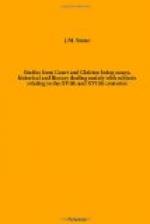The eleven months which elapsed between the 9th September 1513 to the 4th August 1514, were the most eventful of her whole life. The catastrophe of Flodden left her, perhaps not without cause, the least mournful woman in Scotland, for James iv., with all the heroism that attaches to his name, had little claim to be called a faithful husband. Unhindered, therefore, by any excess of grief, she was the better able to attend to the affairs of State, and to hasten the coronation of her little son, a baby of one year and five months. In December she convened the Parliament of Scotland to meet at Stirling Castle, and formally took up the dignity of regent with the consent of the assembled nobility of the realm. At this sitting the greatest unanimity prevailed. In the Acts of the Privy Council of Scotland, under date 12th January 1514, occurs the following entry: “To advise of the setting up of the Queen’s household, and what persons and officers are necessary thereto, and to advise of the expenses for the supportation of the same, and by what ways it shall be gotten.” All was peace for a short time, and the most friendly relations existed between the queen and her Council, till the first high-handed attempt of Henry VIII. to interfere through his sister in the government of Scotland, resulted in her temporary banishment, and the removal of the infant king from his mother’s care.*
* P. Martyr, Ep. 535. For a detailed account of the state of Scotland for the first nine years after the disastrous defeat at Flodden, see vol. xiv. Of the Exchequer Rolls of Scotland, edited by George Burnett, LL.D., Lyon King-of-Arms, and A. Y. G. Mackay, M.A. (Oxon.), LL.D. (Edin.), etc., His Majesty’s General Register House, Edinburgh.
On the 30th April Margaret gave birth to a posthumous son, who received the title of Duke of Rothesay; and scarcely had she reappeared in public after the birth of this child, when an envoy from the Emperor Maximilian brought overtures of marriage. About the same time, she received a like proposal from Louis XII. of France, who afterwards married her younger sister Mary. Dismissing both aspirants to her hand, before the first year of her widowhood had run its course, she married Archibald, Earl of Angus, Margaret being in her twenty-fifth, he in his nineteenth year. The union was equally unfortunate for the queen herself and for her wretched husband, who, when the first charm of novelty had passed, was disdainfully flung aside, and never restored to favour.
There was an ancient custom of the realm, which placed the executive power and the person of the king, should he be a minor at the death of the preceding sovereign, in the hands of the next male heir, and the appointment of James’s widow to the regency and the guardianship of his son was made in distinct disregard of all recognised precedent. The consent of the Scottish lords to the innovation had been given entirely from a sense of loyalty to their beloved and unfortunate monarch James iv. But a proviso had been made in his will, that in the event of the queen’s remarriage, the regency, as well as the guardianship of the king, should pass to John, Duke of Albany, the next heir to the throne.




